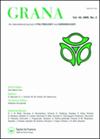Pollen assemblage variability of Apis mellifera honeys (Diamante, Entre Ríos, Argentina)
IF 1
4区 生物学
Q4 PLANT SCIENCES
引用次数: 0
Abstract
Abstract The pollen assemblage of 27 honey samples produced by Apis mellifera from three apiaries in the Diamante department, Entre Ríos (Argentina) were analysed. The study area is highly anthropised with cereal, oilseed and forage crops. The samples were obtained sequentially over four apicultural seasons (1999–2000; 2000–2001; 2001–2002; 2002–2003). In each season, one to three honey extractions, corresponding to the initial (I), middle (II) and final (III) productive periods, were made. Pollen assemblage of the honey reflected the study area vegetation. Monofloral honey were exclusively from exotic species, mainly of the dominant crops. Monofloral honey of Lotus corniculatus, Melilotus albus, Medicago sativa, Ammi, Glycine max and ‘clovers’ were obtained. The monofloral honey corresponded to 87.5%, 50% and 66%, respectively, to the honeys obtained in each productive period over the four apicultural seasons. The intra-annual variation of the samples responded to the phenology of the plant species. The inter-annual variations were associated with differential foraging, and the amount of precipitation during the apicultural period. Significant variations were observed when each apiary is compared to itself in different apicultural seasons, and in identical productive periods. Apis mellifera used a fraction of the available flora as nectar resources. The number of plant species visited remained relatively constant throughout the productive periods although it was higher during the apicultural seasons with lower rainfall.蜜蜂花粉组装变异性(钻石,恩特雷奥斯,阿根廷)
摘要对阿根廷恩特雷里奥斯迪亚曼特省三个养蜂场的27个蜜蜂蜂蜜样品的花粉组合进行了分析。研究区种植了大量的谷物、油籽和饲料作物。样本是在四个养蜂季节(1999-2000年;2000-2001年;2001-2002年;2002-2003年)依次获得的。在每个季节,对应于最初(I)、中期(II)和最后(III)的生产期,进行一到三次蜂蜜提取。蜂蜜的花粉组合反映了研究区域的植被。单花蜂蜜完全来自外来物种,主要是优势作物。获得了飞花莲花、白莲花、紫花苜蓿、Ammi、Glycine max和“丁香”的单花蜜。在四个养蜂季节的每个生产期,单花蜂蜜分别占蜂蜜产量的87.5%、50%和66%。样品的年内变化对植物物种的酚学有响应。年际变化与不同的采食量和养蜂期的降水量有关。当在不同的养蜂季节和相同的生产期对每个养蜂场进行比较时,观察到了显著的差异。蜜蜂使用了一小部分可用的植物作为花蜜资源。在整个生产期,到访的植物物种数量保持相对恒定,尽管在降雨量较低的养蜂季节数量较高。
本文章由计算机程序翻译,如有差异,请以英文原文为准。
求助全文
约1分钟内获得全文
求助全文
来源期刊

Grana
生物-植物科学
CiteScore
2.10
自引率
11.10%
发文量
23
审稿时长
>12 weeks
期刊介绍:
Grana is an international journal of palynology and aerobiology. It is published under the auspices of the Scandinavian Palynological Collegium (CPS) in affiliation with the International Association for Aerobiology (IAA). Grana publishes original papers, mainly on ontogony (morphology, and ultrastructure of pollen grains and spores of Eucaryota and their importance for plant taxonomy, ecology, phytogeography, paleobotany, etc.) and aerobiology. All submitted manuscripts are subject to initial appraisal by the Editors, and, if found suitable for further consideration, to peer review by independent, anonymous expert referees. All peer review is single blind and submission is online via ScholarOne Manuscripts.
 求助内容:
求助内容: 应助结果提醒方式:
应助结果提醒方式:


